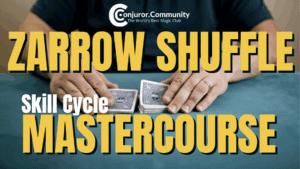- Why “Natural” Is the Last Thing You Should Try to Look →
- The Real Secret to the Zarrow Shuffle →
- From Frustration to Flow →
A case study in how real progress actually happens
This is Part 3 of our series on mastering invisibility in sleight-of-hand.
In Part 1, Why “Natural” Is the Last Thing You Should Try to Look, we looked at why what we call “naturalness” is really uniformity—the sameness that hides method in plain sight.
In Part 2, The Real Secret to the Zarrow Shuffle, we explored how feedback, especially sound, turns frustration into immediate progress.
Now, in Part 3, we’re going to bring those lessons together.
This isn’t just about one shuffle or one course—it’s about how progress actually feels when practice works the way it’s supposed to.
When Steve Reynolds taught his landmark Zarrow Shuffle course, we saw fifty magicians of every level transform over three short sessions. What happened in that room became one of the clearest demonstrations I’ve ever seen of how to move from effort to ease—from frustration to flow.
Most magicians don’t quit because they lose interest.
They quit because practice never starts to feel good.
In Parts 1 and 2 of this series, we looked at what creates that feeling of progress—uniformity and feedback—and why Steve Reynolds’s Zarrow Shuffle became the perfect example.
This final part isn’t just about that shuffle.
It’s a case study in how learning anything can feel simple, quick, and satisfying when the practice itself is built the right way.
Session 1 – Build the honest action
We began with the fair table riffle—just the real shuffle.
Hand position, packet meet, release path, stable forearms.
No false work.
No secrecy.
The goal was to make the honest action read perfectly.
When that’s true, every false version has somewhere to live.
What surprised many people in the room was how unfamiliar the fair riffle really was.
Once Steve adjusted the meet angle and the way the packets rested on the table, everyone’s shuffle suddenly looked calmer.
That was the first click: a correct fair action feels effortless.
It gives you a place to return when the hands drift or tense up.
Between sessions, most participants practiced in short bursts—ten or twenty minutes at a time.
They weren’t “drilling.”
They were exploring.
A brief, continuous shuffle sequence—thirty to sixty seconds—was enough.
Notice what felt rough, change one variable, and run again.
Those few minutes were enough to let the new feel settle in.
Session 2 – Turn feedback up
We opened the next week by revisiting the same fair riffle.
Then Steve added one refinement: listen.
When the release was even, the room grew quiet.
The shuffle stopped sounding like a scatter of clicks and became a single soft breath of cards.
That sound confirmed the action was uniform.
It meant tension had left the hands.
Only then did Steve introduce participants to the false action—the deceptive phase of the shuffle that hides within the fair one.
With the fair riffle already steady, the false shuffle simply read as more of the same.
Everyone could see—and hear—why the method disappears when rhythm and tone stay consistent.
Over the following days, people used the same short practice bursts as before: one brief sequence at a time, one change per attempt, constant reference to the fair shuffle.
Because the feedback was clear, improvement felt immediate.
You could tell what helped.
Practice stopped feeling like effort and started feeling like discovery.
Session 3 – Integration and real use
By the third meeting, most shuffles in the room sounded identical from start to finish.
Steve gave a few fine-tuning notes, then had everyone move the shuffle into actual performance contexts—simple tricks where a false riffle belongs.
That step was crucial.
A technique becomes real only when it works inside real timing.
Once people tried it in routines, they found the tension didn’t spike.
The move felt calm.
That calmness is confidence.
It’s when the sleight stops being a move and starts being part of you.
What this process proves
The Zarrow course wasn’t about one move—it was a demonstration of how organized practice works for any move.
- Start with one honest action.
- Add one clear feedback loop.
- Work in short, continuous bursts.
- Adjust one element at a time.
- Revisit the honest action often.
- Integrate it into real timing early.
That’s the sequence that turned fifty different shuffles into one unified rhythm in a single afternoon—and kept improving over two short weeks.
Why it feels good to keep going
Repetition hardens habits; exploration shapes them.
When you organize practice around discovery, ten or twenty minutes become exactly the right amount of time.
Each small success lands before fatigue or doubt sets in.
That’s why these students came back after the course still using what they learned.
It worked—and it felt good.
Experience the Process for Yourself
What you’ve read in this series is exactly how real progress happens—short, organized practice that produces results fast.
Steve Reynolds’s Complete Zarrow System takes you through the same journey from foundation to flow, with guided commentary from Aaron Fisher & Alex Slemmer.
You’ll get:
- Module 1 – The Fair Riffle, Rebuilt – positions, meet, release, and stable contact.
- Module 2 – The Zarrow, Integrated – alignments and timing that make the false read as fair.
- Module 3 – Live Diagnostics Library – real student shuffles and fixes you can recognize by ear and feel.
Learn the Ultimate Invisible Shuffle
Explore Steve Reynolds’ complete Zarrow system — with guided commentary from Aaron Fisher and Alex Slemmer.
Regular Price $397
Today: $297

